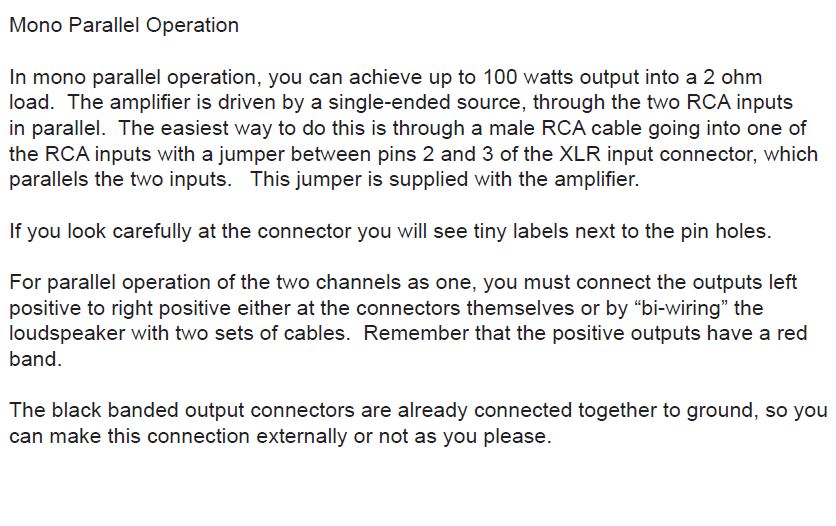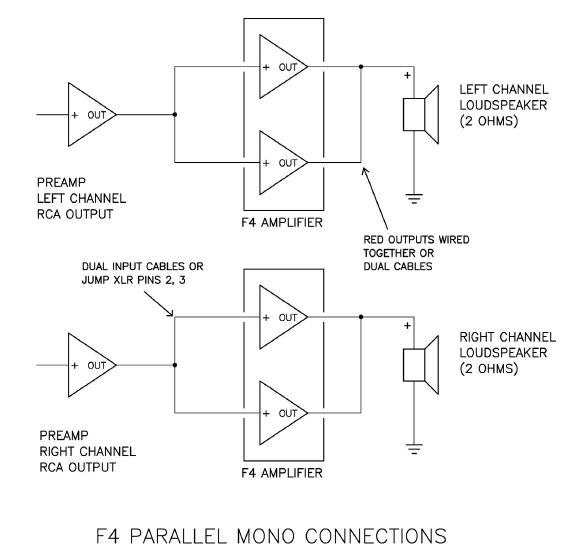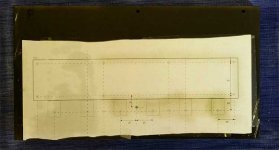I bought my MOSFETs from Alweit also.
Mine were extremely well matched.
As far as making an F4 monoblock......you could try an input transformer.
1:2 w/ CT secondary or somethig.
I did some preliminary testing and it worked quite well, I never actually built the second F4 though.
Mine were extremely well matched.
As far as making an F4 monoblock......you could try an input transformer.
1:2 w/ CT secondary or somethig.
I did some preliminary testing and it worked quite well, I never actually built the second F4 though.
Hey I'm feeling like a Dodo! I can't figure out how to make an F4 into a mono amp.
I like mine so much I think I need a second...make a pair of mono's...but I don't know how to change the circuit/wiring/boards...
I was waiting for someone else to ask because don't remember it in the F4 threads.
Something simplified to hook this wire to here, replace this with that. Intent here is to build them as mono blocks, run them in parallel for a year, then move wires over for blanched use when I have a balanced preamp built. Have all the parts ready and under assembly - minus one transformer if is done using the exact same parts as stereo amps.
I see the reply about using XLR, and realize the factory amps came with both inputs with explanations on what to jumper but F4 build guides haven't covered it. So don't know about others building or testing F4 mono blocks, but I'm making the risky assumption they are starting without a balanced preamp.
In the F4 manual Pass states they connections are labeled on factory amps. Obviously not for home builders.
In that case the ground is done at the amp, where the pictures from the manual show the negative terminal being brought to earth ground, and I were to follow that as a newbie I would assume it means bring a wire back to ... where. Running a cable back to the amps would be split to two chassis grounds?
Sticking to parallel for the time being...


Dodo question, but don't want to make a major Dodo mistake.
... and I'm driving 4 ohm speakers
Einric, I don't get the input transformer's application (don't be surprised, just trying to follow instructions). Since it wasn't listed in the F4 factory manual I'm assuming it can be done without? My current plan is to use one 400VA Antek transformer per mono block.
Last edited:
Einric, I don't get the input transformer's application (don't be surprised, just trying to follow instructions). Since it wasn't listed in the F4 factory manual I'm assuming it can be done without?
If you use an input transformer to convery your Single ended source (RCA) to balanced (XLR) your amp will be in bridge mode and be 100WPC instead of 50WPC
Which raises a question, does your preamp have balanced out?
The input transformer + goes to L channel +.
The input transformer - goes to R channel +.
The CT is ground to both RCA's.
This is essentially the XLR balanced scheme but you use an input transformer to give the negative output.
Then 100W into 8R is possible from a single RCA source.
The input transformer - goes to R channel +.
The CT is ground to both RCA's.
This is essentially the XLR balanced scheme but you use an input transformer to give the negative output.
Then 100W into 8R is possible from a single RCA source.
Well ZM, I never quite caught the distinction. From the pictures parallel seems to be what "balanced" means. It looks like (im such a child with this stuff) one side of the amp increases the part or the signal above ground while the other side increases the part below ground. The speaker reacts to the ongoing summed difference.
I have no idea how a transformer could create this kind of signal from one that is all above ground (single ended?)
Bridged mono seems like a team of oxen, both pulling at the same time, to the same extent at the same que. Bridged seems trickier...somehow. but this is essentially why we must match mosfets, they pull in concert to the extent they are identical in their thirst for current, yes?
Big question which works better?
But this is mute if my best preamp is single ended.
I have no idea how a transformer could create this kind of signal from one that is all above ground (single ended?)
Bridged mono seems like a team of oxen, both pulling at the same time, to the same extent at the same que. Bridged seems trickier...somehow. but this is essentially why we must match mosfets, they pull in concert to the extent they are identical in their thirst for current, yes?
Big question which works better?
But this is mute if my best preamp is single ended.
Refrencing the CT as ground will create a positive sine wave when you measure from top to CT and a negative wave from bottom to CT.
The key is, from a single rca source the secondary CT will cut the signal in half like a "phase splitter" that is why you need something like a 1:2 transformer to get each half refrenced from the CT to be equal in amplitude to the input signal.
That way the L channel amplifies the positive sine and the R channel amplifies the negative sine.
Then at the output you get a parallel output that has double the amplitude.
Same as XLR, Pos,Gnd,Neg.......+,CT,-......it's just a different way to skin the pig��.
The key is, from a single rca source the secondary CT will cut the signal in half like a "phase splitter" that is why you need something like a 1:2 transformer to get each half refrenced from the CT to be equal in amplitude to the input signal.
That way the L channel amplifies the positive sine and the R channel amplifies the negative sine.
Then at the output you get a parallel output that has double the amplitude.
Same as XLR, Pos,Gnd,Neg.......+,CT,-......it's just a different way to skin the pig��.
I have no idea how a transformer could create this kind of signal from one that is all above ground (single ended?)
<Yoda>
Such things as Ground there is not...
Where you make it is "Ground".
</Yoda>
More info when I have time to make some diagrams.
You give me hope  ZM
ZM
At base level I have noted that more power tends to mean more control and separation of duties (mono) also brings clarity, this is why i think a second F4 might help.
I have a single F4 driving Kef 104/2s: 90dB 4 Ohm nominal. My preamp is Supratek Chenin. I like the MC phono. TT is Linn LP12, cart is .4mV out. Its pushing it to get adequate volume without degradation on some recordings. The Chenin does not like being pushed past 80 percent of knob twist...could be inadequate tubes or funky pulse in household e but i get DC thumps.
I dont know if i could build a phono section with more gain, maybe a Pearl 2 with a MC step up but i couldnt say. Pear into BA3FE?
I have an Aleph J but that does not like the 4 Ohm load.
But hey, I Know I can build an F4, so it seems like its worth a shot.
At base level I have noted that more power tends to mean more control and separation of duties (mono) also brings clarity, this is why i think a second F4 might help.
I have a single F4 driving Kef 104/2s: 90dB 4 Ohm nominal. My preamp is Supratek Chenin. I like the MC phono. TT is Linn LP12, cart is .4mV out. Its pushing it to get adequate volume without degradation on some recordings. The Chenin does not like being pushed past 80 percent of knob twist...could be inadequate tubes or funky pulse in household e but i get DC thumps.
I dont know if i could build a phono section with more gain, maybe a Pearl 2 with a MC step up but i couldnt say. Pear into BA3FE?
I have an Aleph J but that does not like the 4 Ohm load.
But hey, I Know I can build an F4, so it seems like its worth a shot.
Placement of MOSFET's in relation to heatsinks.
While I chew on the possibility of input transformers to avoid building a balanced preamp... not knowing where to begin...
How about something else entirely. Tomorrow I center punch the holes for where I'm going to mount the F4 board and MOSFET's to the heatsink. It's 300mm x 165mm, same dimensions as the ones sold by the DIY store. I'm wondering where to place the MOSFET's specifically and took this as a guess. Yes, the paper was a little dirty, but I made it look much worse in photoshop by burning in what didn't show up due to poor lighting and a cell phone camera.
The amps will be a few inches above the ground, heatsinks oriented the usual manner, fins running up and down to allow for some convection.

The board is not centered, but a little lower without getting to what i would have guessed to be too low. Just a guess, figure there must be someone else here who has done a few builds and wished they had done something a little different.
While I chew on the possibility of input transformers to avoid building a balanced preamp... not knowing where to begin...
How about something else entirely. Tomorrow I center punch the holes for where I'm going to mount the F4 board and MOSFET's to the heatsink. It's 300mm x 165mm, same dimensions as the ones sold by the DIY store. I'm wondering where to place the MOSFET's specifically and took this as a guess. Yes, the paper was a little dirty, but I made it look much worse in photoshop by burning in what didn't show up due to poor lighting and a cell phone camera.
The amps will be a few inches above the ground, heatsinks oriented the usual manner, fins running up and down to allow for some convection.
The board is not centered, but a little lower without getting to what i would have guessed to be too low. Just a guess, figure there must be someone else here who has done a few builds and wished they had done something a little different.
Attachments
Hey ZM,
I'm at the highest setting for gain.
I think perhaps their claim of 0.1mV is based on maybe 1V out, some amps can work with that. The F4...not so much.
I need just a little more gain me thinks. I'll have to think a bit about how best to get that. I wondering about all sorts of means including now maybe a spudamp with a 46...I have a lot of those...but for all that iron might as well do a step up tx...or a new cartridge, or...
Meanwhile, I'll work on quieting down my envornment and listening deeper.
Many thanks for considering my problem ZM
I'm at the highest setting for gain.
I think perhaps their claim of 0.1mV is based on maybe 1V out, some amps can work with that. The F4...not so much.
I need just a little more gain me thinks. I'll have to think a bit about how best to get that. I wondering about all sorts of means including now maybe a spudamp with a 46...I have a lot of those...but for all that iron might as well do a step up tx...or a new cartridge, or...
Meanwhile, I'll work on quieting down my envornment and listening deeper.
Many thanks for considering my problem ZM
Hey ZM,
I'm at the highest setting for gain.
I think perhaps their claim of 0.1mV is based on maybe 1V out, some amps can work with that. The F4...not so much.
I need just a little more gain me thinks. I'll have to think a bit about how best to get that. I wondering about all sorts of means including now maybe a spudamp with a 46...I have a lot of those...but for all that iron might as well do a step up tx...or a new cartridge, or...
Meanwhile, I'll work on quieting down my envornment and listening deeper.
Many thanks for considering my problem ZM
point is - knowing gain of your line level preamp , along with it's input overload level and output levels of your sources ( both line level ones and >cart+phono section< as entity)...... to know do you need more gain with existing sources , or do you need more cojones from amp itself
30db of gain (being around 30V/V) , as declared for your preamp , will certainly clip poor F4 with standard 2Vrms line level source
so , if you're now lacking grunt , it's either poor source or time for bigger hammer
as in - don't use force , use bigger hammer
Last edited:
- Home
- Amplifiers
- Pass Labs
- A guide to building the Pass F4 amplifier
